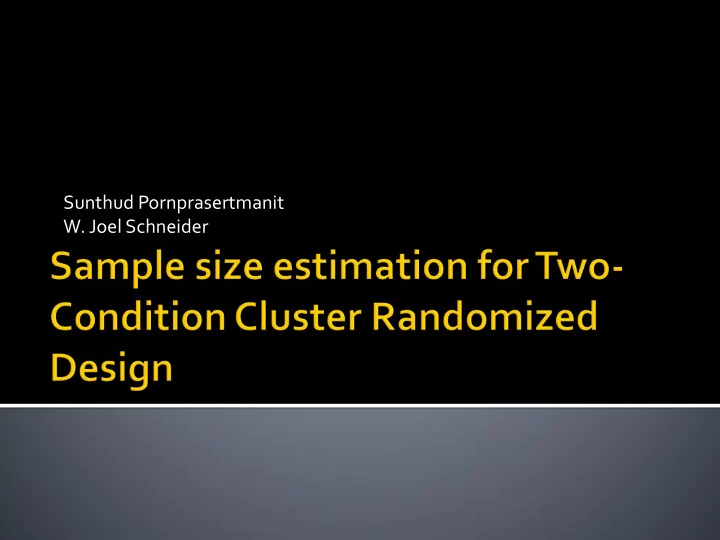

Sunthud Pornprasertmanit W. Joel Schneider
Sample Size Estimation Approach Power Accuracy in Parameter Estimation Cluster Randomized Design (CRD) Sample Size Estimation in CRD Program Illustration
Power analysis The probability of a significant result when there is a real effect in the population Width of Confidence Interval of Effect Size ( CI of ES ) The accuracy of effect size estimation
97.5 %tile 1 - power %tile 1 - 2 = 0 1 - 2 Critical value Effect Size = 0 Specified Parameter ES More n Less SE More power
95 % CI of Cohen’s d 97.5 %tile 2.5 %tile 1 2 d CI of ES Lower bound Upper bound More n Less SE Narrower Width of CI of ES
CRD is the analysis of group differences when groups are randomly assigned to different conditions Independent t-test Two-condition CRD j 2 j 3 j 4 j 5 j 6 j 7 j 8 j 1 J = 8 All sample size = 24 All sample size = 24 n = 3
Using Independent t -test Independence of error terms assumption has been violated ▪ Similar experience within clusters Inflate type I error CRD accounts for interdependence
Two types of errors in CRD Group-level error variance Individual-level error variance Intraclass correlation (ICC) Group error variance ICC Group error variance Individual error variance
Covariate Effect in CRD Achievement M SES M Achievement Between-group effect Within-group effect j 4 j 3 Large Effect between Schools j 2 Small Effect within each school j 1 SES
Effect Size Definition 1 2 In single level design, is pooled SD or MS error In CRD, three types of pooled SD Group or Individual or 2 Total or 2
Hedges (2007) guideline In this study, use only individual pooled SD Assume = 1 Effect Size = Condition Difference
Formula by Hedges (2007) Phantom Variable Method by SEM packages Y on X Effect Size 2 Within Find CI of ES based on Wald Statistic
Different Combination of three factors can yield the same power or width of CI Number of Clusters ( J ) Cluster size ( n ) Proportion of treatment clusters ( p ) Different Combination also yield same costs
Four costs Treatment Individual Cost (TIC) Control Individual Cost (CIC) Treatment Group Cost (TGC) Control Group Cost (CGC) Each Treatment Group Cost = TGC + ( n x TIC ) Number of Treatment Groups = pJ Each Control Group Cost = CGC + ( n x CIC ) Number of Control Groups = (1 – p ) J Total Cost = pJ ( TGC + ( n x TIC )) + (1 – p ) J ( CGC + ( n x CIC )
Three criteria Minimize number of overall individuals by specified power/width ▪ Find various n , J , p for given power/width Find lowest nJ Minimize cost by specified power/width ▪ Find various n , J , p for given power/width Find lowest cost Maximize power/ Minimize width by specified cost ▪ Find various n , J , p for given cost Find highest power/width
Find starting values by Wald Statistic formula using normal approximation Given individual error variance = 1 Find more accurate result by a priori Monte Carlo Simulation by Mplus
1. What happens when a covariate is added? (Post Hoc) 2. How many classrooms are required to detect a small effect? (A priori)
Effectiveness of training to administer cognitive behavioral therapy (King et al., 2002) 84 therapists assigned to two conditions 4 patients each DV = Beck Depression Inventory (BDI) Score ES with individual-level SD = 0.09 Intraclass correlation = 0.013
Result = ns Post Hoc power = 0.124 If the researchers collected BDI scores of therapists, Cluster-level variable Cluster-level Error Variance Explained = 10% Can the covariate help to achieve high power?
A new teaching method DV = Academic Achievement Intraclass correlation = 0.25 Classroom size = 25 Power = 0.8 Meaningful ES = 0.2
Cost Treatment Control Cluster Cost 600 300 Individual Cost 2 2 How many classrooms should be used?
Recommend
More recommend